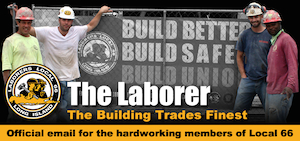
The construction industry routinely accounts for 1 in 10 of all non-fatal workplace injuries and 1 in 5 of all work fatalities. That's higher than in any other industry sector. Local 66 works to improve safety and health on the job by working with employers, members and government agencies. Our members are trained during the Apprenticeship Program on basic workplace safety procedures, while active members are routinely retrained for specific on the job safety precautions. Local 66 Journeymen are the Safety Directors on many major jobsites. We work hard so that one day we will live in a time when construction workers don't lose their lives on the job, but until that day comes, we work tirelessly to make sure that all workers on a jobsite will make it home at the end of the workday.
Safety Tip provided by Laborers International Union of North America
Back, Shoulder, Knee and Other Musculoskeletal Problems
Musculoskeletal (muscle, joint and bone) injuries are the most common injury problem in the construction industry. They are over one-third of all lost workday injuries and produce about half of all compensation claims. In a recent survey, 40 percent of construction workers said "working while hurt" is a major problem. Working while hurt reduces productivity. Continuing to work while hurt will result in disabling injuries that can end a career. Many Laborers end up retiring by age 55 because they just can't do the work any more. Many can't enjoy their retirement because of their disabilities.
Ergonomics means finding ways to make the work easier so workers can work smarter, not harder. It means asking experienced workers for their ideas on how to do the work. Usually, it ends up making the job more productive since workers are less often fatigued or hurt. Ergonomic changes, generally, are not expensive and can be very simple.
Types of ergonomic changes include:
- Planning Planning the job to minimize manual handling of heavy materials - making sure crane time is available, forklifts are used maximally and materials are delivered and stored close to where they will be used
- Storing materials so they are accessible and easier to get to (e.g., not above shoulder height or at ground level), but not in the way of on-going work
- Making sure that walkways are clear and even so carts and dollies can be easily employed
- Tools and Equipment Using better, ergonomically-designed tools which may be lighter weight, require less force to operate or fit the hand better and are more comfortable to use
- Using carts, dollies and hoists to move materials as much as possible rather than brute strength
- Using handles when carrying loads
- Using protective equipment like knee pads and shoulder pads to reduce the contact stresses of kneeling work or carrying materials
- Cooperation Getting help when needed to handle heavy loads - some companies set weight limits (like 50 pounds) above which a helper is required
- Organizing stretching programs before work begins each day
- Materials Using lighter materials, such as lighter weight block
- Training Training workers and foremen to identify ergonomic risk factors and common solutions
Most important is setting up an "ergonomics process" - a regular time, perhaps during safety meetings, to talk about ergonomic issues, get ideas from the members on how jobs could be improved, test out those ideas and decide if they were real improvements. Many companies are beginning to look at ergonomic problems and work on solutions because it makes business sense even in the absence of an OSHA regulation. The Laborers' Health and Safety Fund of North America has professional staff who can help contractors and members come up with and evaluate ergonomic solutions for any worksite. Laborers-AGC also has a one-hour ergonomics awareness training for members available at its training centers.

